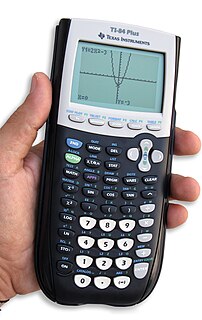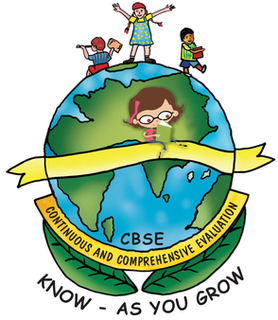Related Research Articles
Educational software is a term used for any computer software which is made for an educational purpose. It encompasses different ranges from language learning software to classroom management software to reference software. The purpose of all this software is to make some part of education more effective and efficient.

A graphing calculator is a handheld computer that is capable of plotting graphs, solving simultaneous equations, and performing other tasks with variables. Most popular graphing calculators are programmable calculators, allowing the user to create customized programs, typically for scientific, engineering or education applications. They have large screens that display several lines of text and calculations.
Moodle is a free and open-source learning management system (LMS) written in PHP and distributed under the GNU General Public License. Developed on pedagogical principles, Moodle is used for blended learning, distance education, flipped classroom and other e-learning projects in schools, universities, workplaces and other sectors.
Optical mark recognition is the process of reading information that people mark on surveys, tests and other paper documents.
Educational assessment or educational evaluation is the systematic process of documenting and using empirical data on the knowledge, skill, attitudes, and beliefs to refine programs and improve student learning. Assessment data can be obtained from directly examining student work to assess the achievement of learning outcomes or can be based on data from which one can make inferences about learning. Assessment is often used interchangeably with test, but not limited to tests. Assessment can focus on the individual learner, the learning community, a course, an academic program, the institution, or the educational system as a whole. The word 'assessment' came into use in an educational context after the Second World War.

The Scottish Qualifications Authority is the executive non-departmental public body of the Scottish Government responsible for accrediting educational awards. It is partly funded by the Education and Lifelong Learning Directorate of the Scottish Government, and employs approximately 750 staff based in Glasgow and Dalkeith.
In the Scottish secondary education system, the Higher is one of the national school-leaving certificate exams and university entrance qualifications of the Scottish Qualifications Certificate (SQC) offered by the Scottish Qualifications Authority. It superseded the old Higher Grade on the Scottish Certificate of Education (SCE). Both are normally referred to simply as "Highers".
Electronic assessment, also known as digital assessment, e-assessment, online assessment or computer-based assessment, is the use of information technology in assessment such as educational assessment, health assessment, psychiatric assessment, and psychological assessment. This covers a wide range of activity ranging from the use of a word processor for assignments to on-screen testing. Specific types of e-assessment include multiple choice, online/electronic submission, computerized adaptive testing such as the Frankfurt Adaptive Concentration Test, and computerized classification testing.
A learning management system (LMS) is a software application for the administration, documentation, tracking, reporting, automation, and delivery of educational courses, training programs, or learning and development programs. The learning management system concept emerged directly from e-Learning. Learning management systems make up the largest segment of the learning system market. The first introduction of the LMS was in the late 1990s. Learning management systems have faced a massive growth in usage due to the emphasis on remote learning during the COVID-19 pandemic.
Educational technology is the combined use of computer hardware, software, and educational theory and practice to facilitate learning. When referred to with its abbreviation, edtech, it is often referring to the industry of companies that create educational technology.
Summative assessment, summative evaluation, or assessment of learning is the assessment of participants where the focus is on the outcome of a program. This contrasts with formative assessment, which summarizes the participants' development at a particular time. Summative assessment is widely taught in educational programs in the United States. Michael Scriven claims that while all assessment techniques can be summative, only some are formative.
Formative assessment, formative evaluation, formative feedback, or assessment for learning, including diagnostic testing, is a range of formal and informal assessment procedures conducted by teachers during the learning process in order to modify teaching and learning activities to improve student attainment. The goal of a formative assessment is to monitor student learning to provide ongoing feedback that can help students identify their strengths and weaknesses and target areas that need work. It also helps faculty recognize where students are struggling and address problems immediately. It typically involves qualitative feedback for both student and teacher that focuses on the details of content and performance. It is commonly contrasted with summative assessment, which seeks to monitor educational outcomes, often for purposes of external accountability.
The IMS Question and Test Interoperability specification (QTI) defines a standard format for the representation of assessment content and results, supporting the exchange of this material between authoring and delivery systems, repositories and other learning management systems. It allows assessment materials to be authored and delivered on multiple systems interchangeably. It is, therefore, designed to facilitate interoperability between systems.

Continuous and Comprehensive Evaluation (CCE) was a process of assessment, mandated by the Right to Education Act, of India in 2009. This approach to assessment was introduced by state governments in India, as well as by the Central Board of Secondary Education in India, for students of sixth to tenth grades and twelfth in some schools. From this the smaller classes student would have a practice to face the exam of board in younger age. The Karnataka government introduced CCE for grades 1 through 9 later it was also introduced for 12th grades students. The main aim of CCE was to evaluate every aspect of the child during their presence at the school. This was believed to help reduce the pressure on the child during/before examinations as the student will have to sit for multiple tests throughout the year, of which no test or the syllabus covered will be repeated at the end of the year, whatsoever. The CCE method was claimed to bring enormous changes from the traditional chalk and talk method of teaching, provided it is implemented accurately.
Adaptive learning, also known as adaptive teaching, is an educational method which uses computer algorithms as well as artificial intelligence to orchestrate the interaction with the learner and deliver customized resources and learning activities to address the unique needs of each learner. In professional learning contexts, individuals may "test out" of some training to ensure they engage with novel instruction. Computers adapt the presentation of educational material according to students' learning needs, as indicated by their responses to questions, tasks and experiences. The technology encompasses aspects derived from various fields of study including computer science, AI, psychometrics, education, psychology, and brain science.
Continuous assessment is a form of educational examination that evaluates a student's progress throughout a prescribed course. It is often used as an alternative to the final examination system. Proponents of continuous assessment argue that the approach allows tracking of progress and has a chance of offering students more support, guidance, and opportunities to improve during the course or programme.

An examination or test is an educational assessment intended to measure a test-taker's knowledge, skill, aptitude, physical fitness, or classification in many other topics. A test may be administered verbally, on paper, on a computer, or in a predetermined area that requires a test taker to demonstrate or perform a set of skills.

Kahoot! is a game-based learning platform, used as educational technology in schools and other educational institutions. Its learning games, "kahoots", are user-generated multiple-choice quizzes that can be accessed via a web browser or the Kahoot! app. Kahoot! can be used to review students' knowledge, for formative assessment, or as a break from traditional classroom activities. Kahoot! also includes trivia quizzes. This educational platform is similar to other technological learning tools, such as Wooflash, Socrative, or Quizlet.
Electronic exams offer benefits such as ease of marking, reduced need to read illegible handwriting, saving of time
Haggis is a high-level reference programming language used primarily to examine computing science for Scottish pupils taking SQA courses on the subject. Haggis is used as a tool to bridge the gap between pseudocode and typical computer programming.
References
- ↑ "Computer Aided Assessment – Technology Enhanced Learning". Archived from the original on 17 October 2011. Retrieved 22 February 2018.
- ↑ Quiz OMR" : An extension to Moodle to provide online support for offline quizzes conducted on OMR sheets http://moodle.org/mod/data/view.php?d=13&rid=3601
- ↑ Gomersall 2005
- ↑ Scottish Qualifications Authority 2008
- Einig, Sandra (2013). "Supporting Students' Learning: The Use of Formative Online Assessments". Accounting Education. 22 (5): 425–444. doi:10.1080/09639284.2013.803868. S2CID 145403309.
- Gomersall, Bob (2005-12-10). Practical implementation of e-testing on a large scale, and implications for future eassessment and e-learning (PDF). Shipley, West Yorkshire, UK. Retrieved 2007-10-01.
- Scottish Qualifications Authority (2008). "SOLAR White Paper" (PDF). Glasgow, UK. Retrieved 2008-02-15.